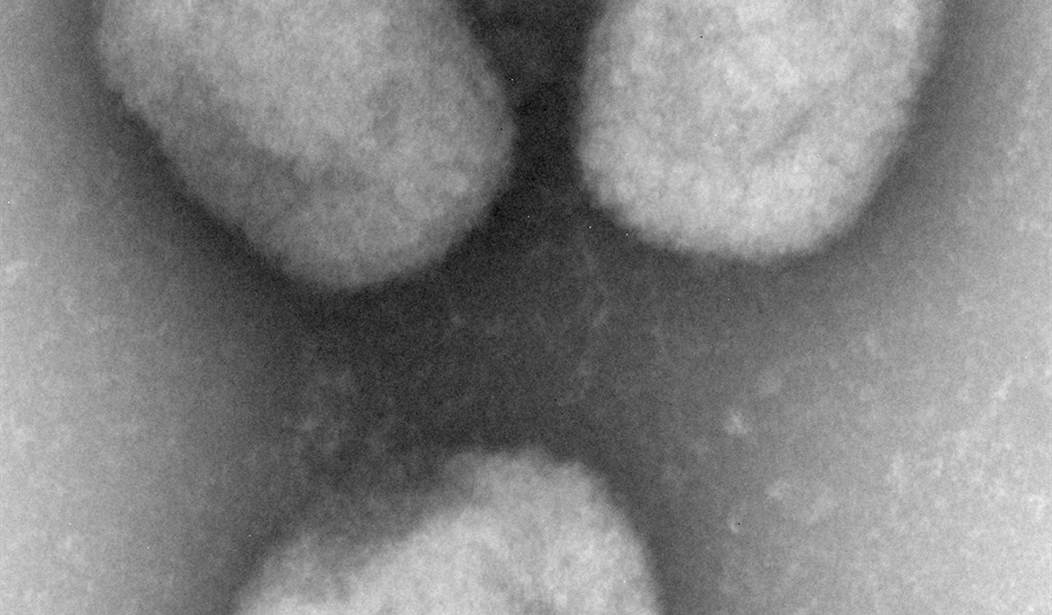There’s been a debate about how monkeypox is being transmitted since it first began making headlines in the US back in May. Eventually the conclusion seen in most public health warnings was that monkeypox was being spread by close skin-to-skin contact which naturally happens during sex. But today, NBC News reports on some new evidence which suggests it’s not skin contact but sex between men which is the main way the virus is spreading.
In recent weeks, a growing body of scientific evidence — including a trio of studies published in peer-reviewed journals, as well as reports from national, regional and global health authorities — has suggested that experts may have framed monkeypox’s typical transmission route precisely backward.
“A growing body of evidence supports that sexual transmission, particularly through seminal fluids, is occurring with the current MPX outbreak,” said Dr. Aniruddha Hazra, medical director of the University of Chicago Sexual Wellness Clinic, referring to monkeypox and to recent studies that found the virus in semen.
Consequently, scientists told NBC News that the Centers for Disease Control and Prevention and other public health authorities should update their monkeypox communication strategies to more strongly emphasize the centrality of intercourse among gay and bisexual men, who comprise nearly all U.S. cases, to the virus’ spread.
NBC highlights an analysis of the question (How is monkeypox being spread?) which was published on Medium last week by Dr. Jeffrey Klausner, a professor of medicine at USC. Dr. Klausner pointed to three specific pieces of evidence including a recent study which, “identified protracted shedding over 19 days of human monkeypox DNA in the semen of an infected individual.” Dr. Klausner called the identification of monkeypox as an STD a double-edged sword.
The ramifications of classifying human monkeypox as a sexually transmitted infection are double-edged. The stigma surrounding sexually transmitted infections in gay men and other sex with men limits healthcare seeking and partner-notification behaviors [18,19], directly subverting our primary means of outbreak control — namely, early identification and behavior change in infected individuals. Furthermore, such stigma can fuel further homophobia, particularly in areas without human rights protections for individuals who engage in same-sex relationships [20]. Conversely, failure to appropriately identify and disseminate to the public the predominant mode of transmission will likely perpetuate behaviors that are driving transmission. Identifying high-risk sub-populations, in this case gay, bisexual or other men who have sex with men, who have multiple partners, will facilitate targeted awareness and education efforts, exposure reduction and other disease intervention activities such as testing, treatment and vaccination, which in turn may augment control efforts and prove to be cost effective. Such efforts are analogous to what was eventually implemented in partnership with community-based organizations to combat the human immunodeficiency virus pandemic with notable success [21].
Ultimately, Dr. Klausner comes down on the side of identifying the specific behavior that is likely to be spreading the disease, at least in the US outbreak.
The transmission dynamics of human monkeypox, at least across the United States and Europe, appears to be highly consistent with a sexually transmitted infection. Our public health response, therefore, should incorporate sexual health into its response to the current outbreak, including frank discussion of specific sexual behaviors like condomless anal sex that increase the risk for transmission.
As Allahpundit pointed out yesterday, that message doesn’t seem to be clear to people so far. At present, the general public is nearly as worried about the spread of monkeypox (61%) as are gay men (68%). How this confusion is happening isn’t much of a mystery. As Josh Barro pointed out on Substack last week, public health communication about the disease has been a mess. He singled out a particular interview an Oregon doctor gave to Oregon Public Broadcasting about the disease.
As you know from reading this newsletter, there are several ways that monkeypox can spread, but in this outbreak it largely is spreading though sexual contact between men. So, you would think, when the OPB host asked “what are the best ways for people to reduce their risk of contracting the virus?” Menza might have at least mentioned sex. Unfortunately, he did not. He found time to discuss the risks associated with a handful of other activities — being in an office, learning in a classroom, going to a bar or a club, massaging someone with monkeypox sores, etc. — but couldn’t quite bring himself to say “sex.”
Here’s his interminable answer to that simple question:
We can kind of try to put activities to specific risk levels. Things that I would say are unlikely to transmit hMPXV are things like taking public transportation, going out to eat, going to the grocery store, going to have coffee with friends, being in an office with your coworkers and learning in a classroom. Those things are all low-risk activities. Hanging out outside at a bar or a club or a cafe, totally low risk activities.
Being in more crowded spaces where there’s less clothing and more skin-to-skin contact, like a bar or club perhaps, that’s where that skin-to-skin contact comes into play. We’ve been trying to message to folks to just consider the amount of skin-to-skin contact you might expect in a situation or a place that you might be or an event that you might be attending.
And then the things that then move up in scale are things that include more prolonged skin-to-skin contact. Like perhaps massaging an area with skin that is affected by hMPXV, or hugging in contact with skin that is affected by hMPXV. Or perhaps cuddling. The other thing is we know that when we talk about respiratory secretions we think about saliva too. So things like kissing or sharing a toothbrush might be a little bit higher risk.
And then the things that have the most risk is when there’s that really direct prolonged skin-to-skin contact with the sores, the scabs or the fluids of the rash.
It really does come across as an answer designed to talk about everything except the activity most likely to spread the disease. And if you read on, the doctor in question eventually says explicitly that there are really two sets of messages, one for the general public and one for “community partners” who gave give the actual information needed to reduce transmission to the people who need it.
Menza knows something — that this outbreak is happening almost entirely through gay sex — but in this interview, he’s hiding the ball about that because he doesn’t trust the broad public with that information. He’s concerned that knowledge of this fact will cause people to stigmatize gay men.
Public health officials shouldn’t be playing these kinds of games. They should simply and accurate give the information to the entire public about who is at risk and how the disease is being spread. That shouldn’t be done in a way that stigmatizes and entire group of people. On the other hand it stigmatizes some risky sexual behaviors connected to the spread of the virus maybe that’s not such a bad thing under the circumstances.








Join the conversation as a VIP Member